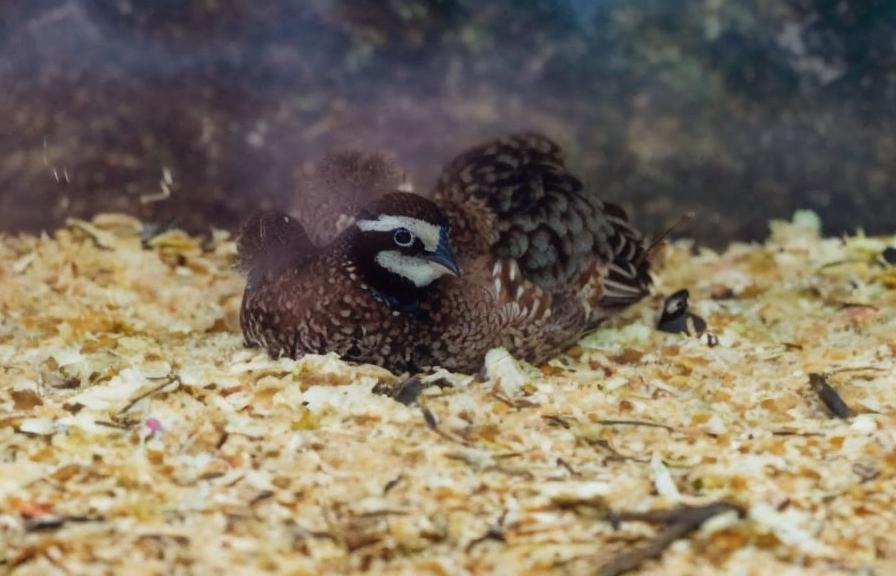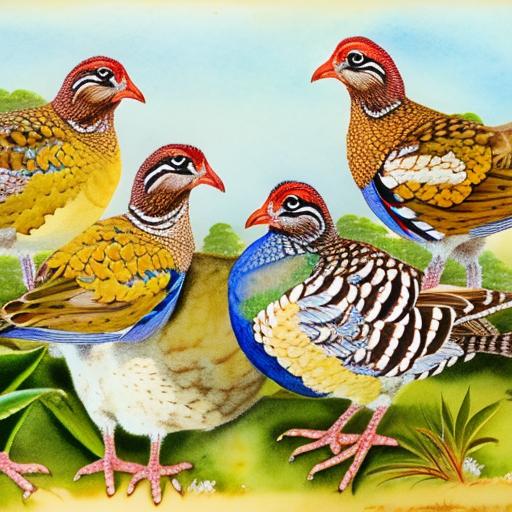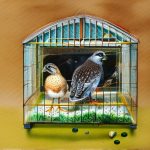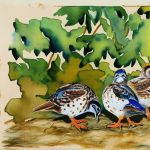Montezuma quail, also known as Mearns’s quail, is a small, elusive bird species native to the southwestern United States and northern Mexico. They are named after the Aztec emperor Montezuma, and are known for their striking plumage and secretive nature. Montezuma quail are a popular game bird among hunters due to their challenging behavior and elusive nature. They are also sought after by birdwatchers and avian enthusiasts for their unique appearance and behavior. Montezuma quail are a fascinating and beautiful species that have captured the interest of many people due to their unique characteristics and behaviors.
Montezuma quail are known for their distinctive appearance, with a striking combination of black, white, and chestnut-colored feathers. They have a unique pattern of white spots on their chest and belly, as well as a distinctive black face mask. Their plumage is highly sought after by birdwatchers and avian enthusiasts for its beauty and uniqueness. Montezuma quail are also known for their secretive behavior, often staying hidden in dense vegetation and only emerging in the early morning or late evening. They are a highly elusive species, making them a challenging and exciting bird to observe in the wild. Montezuma quail are a fascinating and beautiful species that have captured the interest of many people due to their unique characteristics and behaviors.
Key Takeaways
- Montezuma quail are a unique and beautiful breed of quail known for their striking plumage and elusive nature.
- They are small birds with a round body, short tail, and distinctive black and white facial markings.
- Montezuma quail are typically found in mountainous regions of Mexico and the southwestern United States, preferring dense vegetation and oak woodlands.
- These quail are shy and secretive, often foraging for seeds, insects, and plants in the early morning and late afternoon.
- Due to habitat loss and hunting, Montezuma quail are considered a species of concern and efforts are being made to protect and conserve their populations.
Physical Characteristics of Montezuma Quail
Montezuma quail are small, ground-dwelling birds with a distinctive appearance. They have a round body shape, short tail, and small head with a distinctive black face mask. Their plumage is a striking combination of black, white, and chestnut-colored feathers, with white spots on their chest and belly. The male Montezuma quail has a more vibrant and colorful plumage compared to the female, with brighter chestnut-colored feathers and more pronounced white spots. The female Montezuma quail has a more subdued plumage with less vibrant colors and smaller white spots. Both males and females have a short, curved beak that is adapted for foraging on the forest floor.
Montezuma quail have adapted to their forest habitat by developing cryptic plumage that helps them blend in with their surroundings. Their secretive behavior and elusive nature make them difficult to spot in the wild, as they prefer to stay hidden in dense vegetation. Montezuma quail are well-adapted for life on the forest floor, with strong legs and feet that allow them to move quickly and quietly through the underbrush. They are also excellent runners and can quickly disappear into the undergrowth when threatened. Montezuma quail are a fascinating and beautiful species that have captured the interest of many people due to their unique physical characteristics.
Habitat and Range of Montezuma Quail
Montezuma quail are found in a variety of habitats, including oak woodlands, pine-oak forests, and brushy canyons in the southwestern United States and northern Mexico. They prefer dense vegetation and understory cover, where they can forage for seeds, insects, and other small invertebrates. Montezuma quail are highly secretive birds that prefer to stay hidden in dense vegetation, making them difficult to spot in the wild. They are most commonly found in areas with thick underbrush and leaf litter, where they can forage for food and seek shelter from predators.
The range of Montezuma quail extends from southern Arizona and New Mexico to northern Mexico, where they can be found in suitable habitat throughout the year. They are a resident species that does not migrate, preferring to stay in their preferred habitat year-round. Montezuma quail are highly adaptable birds that can thrive in a variety of forested habitats, as long as there is adequate cover and food sources available. They are often found in areas with a mix of open grasslands and dense vegetation, where they can forage for seeds and insects while staying hidden from predators. Montezuma quail are a fascinating and beautiful species that have captured the interest of many people due to their unique habitat preferences and range.
Behavior and Diet of Montezuma Quail
Montezuma quail are highly secretive birds that prefer to stay hidden in dense vegetation, making them difficult to spot in the wild. They are most active in the early morning and late evening, when they emerge from their hiding spots to forage for food. Montezuma quail are ground-dwelling birds that forage for seeds, insects, and other small invertebrates on the forest floor. They use their strong legs and feet to scratch through leaf litter and soil in search of food, using their short, curved beaks to pick up seeds and small insects.
Montezuma quail are social birds that often form small family groups or flocks while foraging for food. They communicate with each other using soft clucking calls and other vocalizations, which help them stay in contact while moving through dense vegetation. Montezuma quail are also known for their elaborate courtship displays, which involve the male puffing up his chest feathers and strutting around the female while making soft calls. These displays are an important part of the breeding behavior of Montezuma quail and help establish pair bonds between males and females. Montezuma quail are a fascinating and beautiful species that have captured the interest of many people due to their unique behaviors and diet.
Conservation Status of Montezuma Quail
The conservation status of Montezuma quail is currently considered to be of least concern, as they have a large range and stable population size. However, there are some concerns about habitat loss and degradation in certain parts of their range, which could impact their long-term survival. Montezuma quail rely on dense vegetation and understory cover for foraging and nesting, so any loss of suitable habitat could have negative effects on their population size.
Conservation efforts for Montezuma quail focus on protecting and restoring their preferred habitat, as well as monitoring population trends and conducting research on their ecology and behavior. By understanding the needs of Montezuma quail and working to protect their habitat, conservationists can help ensure the long-term survival of this unique species. Public awareness and education about the importance of preserving natural habitats for wildlife can also help support conservation efforts for Montezuma quail. Montezuma quail are a fascinating and beautiful species that have captured the interest of many people due to their conservation status and the efforts being made to protect them.
Breeding and Reproduction of Montezuma Quail

Montezuma quail breed during the spring and summer months, when males perform elaborate courtship displays to attract females. These displays involve the male puffing up his chest feathers, strutting around the female, and making soft calls to her. If the female is receptive, she will crouch down on the ground while the male mounts her to copulate. After mating, the female will seek out a suitable nesting site on the forest floor, where she will lay a clutch of 6-12 eggs.
The female Montezuma quail is responsible for incubating the eggs for about 21 days, during which time she will stay hidden in dense vegetation to protect her nest from predators. Once the eggs hatch, the chicks are precocial and able to leave the nest shortly after hatching. The female will lead her brood through dense vegetation while teaching them how to forage for food and avoid predators. Breeding success for Montezuma quail is closely tied to habitat quality and food availability, so conservation efforts that focus on protecting their preferred habitat can help support successful breeding and reproduction. Montezuma quail are a fascinating and beautiful species that have captured the interest of many people due to their unique breeding behaviors.
Tips for Caring for Montezuma Quail as Pets
Montezuma quail are not commonly kept as pets due to their secretive nature and specific habitat requirements. However, if you are considering keeping Montezuma quail as pets, it is important to provide them with a large aviary or outdoor enclosure that mimics their natural habitat. This should include plenty of dense vegetation, leaf litter, and hiding spots where they can stay hidden during the day.
Montezuma quail should be provided with a varied diet that includes seeds, insects, and other small invertebrates to mimic their natural foraging behavior. It is important to provide them with plenty of space to move around and exercise, as they are active birds that require room to roam. Additionally, it is important to provide them with fresh water at all times, as well as regular veterinary check-ups to ensure they remain healthy.
In conclusion, Montezuma quail are a fascinating and beautiful species that have captured the interest of many people due to their unique characteristics, behaviors, and conservation status. While they may not be commonly kept as pets, understanding their natural history can help us appreciate these elusive birds even more. By learning about their habitat preferences, behaviors, diet, breeding habits, and conservation status, we can work towards protecting these unique birds for future generations to enjoy.
If you’re interested in learning more about the best type of coop for your chickens, check out this informative article on Poultry Wizard. Understanding the different coop options can help you provide the best environment for your poultry, just like understanding the specific needs of Montezuma quail breeds can help you care for them properly.
FAQs
What are Montezuma quail breeds?
Montezuma quail breeds are a species of bird that belong to the New World quail family. They are known for their striking plumage and are native to Mexico and parts of the southwestern United States.
What do Montezuma quail look like?
Montezuma quail are small, plump birds with a distinctive appearance. They have a blue-gray head, a chestnut brown body, and a striking black and white facial pattern. The male quail also have a unique white patch on their forehead.
Where do Montezuma quail breeds live?
Montezuma quail are typically found in mountainous regions with dense vegetation, such as pine-oak forests and canyons. They prefer areas with thick undergrowth and are known to be secretive and elusive birds.
What do Montezuma quail eat?
Montezuma quail primarily feed on a diet of seeds, fruits, and insects. They forage on the ground, using their strong legs and feet to scratch and dig for food.
Are Montezuma quail breeds endangered?
Montezuma quail are not currently listed as endangered, but they are considered a species of concern due to habitat loss and fragmentation. Conservation efforts are in place to protect their natural habitats and ensure their long-term survival.
Meet Walter, the feathered-friend fanatic of Florida! Nestled in the sunshine state, Walter struts through life with his feathered companions, clucking his way to happiness. With a coop that’s fancier than a five-star hotel, he’s the Don Juan of the chicken world. When he’s not teaching his hens to do the cha-cha, you’ll find him in a heated debate with his prized rooster, Sir Clucks-a-Lot. Walter’s poultry passion is no yolk; he’s the sunny-side-up guy you never knew you needed in your flock of friends!







